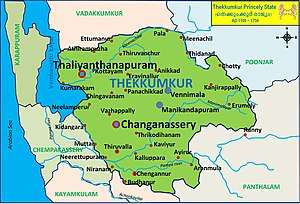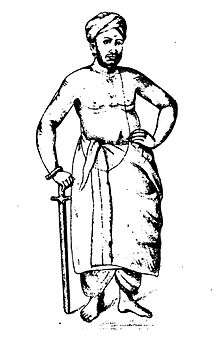Battle of Changanassery
The Battle of Changanacherry was a battle between the old princely states of Thekkumkur and Travancore in September 1749.[1] Defeat in this decisive battle led to Thekkumkur losing its dominance and expanding the Tranvancore empire to the southern border of the river Meenachilar.[2]
| Battle of Changanassery | |||||||
|---|---|---|---|---|---|---|---|
| Part of the Travancore-Thekkumkur War | |||||||
 Map of Thekkumkur Kingdom | |||||||
| |||||||
| Belligerents | |||||||
|
|
| ||||||
| Commanders and leaders | |||||||
|
Marthanda Varma Ramayyan Dalawa Eustachius De Lannoy |
Aditya Varma Manikandan Vazhappadathu Panicker Pathillathil Pottimar | ||||||
| Strength | |||||||
| 10,000-12,000 soldiers | Unknown | ||||||
The kingdom of Travancore was conquered by the princely states of Kayamkulam and Ambalapuzha under the leadership of Ramayyan Dalawa (the Dewan of Travancore). Thekkumkur army provided assistance to counter Travancore's invasion of princely state Ambalapuzha. Realizing this, King Marthanda Varma decided to invade Thekkumkoor following the fall of Champakassery (Ampalapuzha).[3][4]
The cause of the war
In the 13th century, Thekkumkur Rajdhani was shifted to Puzhavathu in Changanassery after Thrikkodithanam, Vennimala[5], Manikandapuram and others. The last king of Thekkumkur was Aditya Varma Manikandan and he resided in the Neerazhi Palace at Changanassery. After hearing of the military advance of the Travancore under the leadership of Ramayyan Dalawa; the crown prince of Thekkumkur then advised Aditya Varma Manikandan to make a friendship with Travancore kingdom by understanding the downfall of princely state Ampalapuzha (Chempakassery) and the fall of princely state Kayamkulam.[6]
Then crown prince (Ilaya rajah) went to Thiruvananthapuram and met Anizham Thirunal Marthanda Varma and requested help. Aditya Varma Manikandan, angry at the crown prince's action, a messenger was sent to Thiruvananthapuram carrying a letter purportedly written by his sick mother.[7] The crown prince had told king Marthanda Varma that this was a strategy to annihilate him, but king persuaded him to go to Changanassery to meet his sick mother and gave him some gifts for Thekkumkur king Aditya Varma Manikandan.
When the young prince reached Thekkumkur, he was assassinated by the royal guards at the behest of his elder brother.[8] The king spread the news that the prince Kotha Varma had died of a snake bite. Recognizing the news from Thekkumkur about the wrong decision of the Thekkumkur king, Marthanda Varma of Travancore ordered Ramayyan Dalawa to march to Thekkumkur and capture the king Aditya Varma Manikandan[9][10]
The War

When the Travancore troops reached Aranmula in the south of Thekkumkur kingdom, the Telugu Brahmins stopped the Travancore army. They were opposed by the Christian and Muslim armies led by De Lannoy. After defeating the Telugu Brahmins at Aranmula, Ramayan Dalawa took over Thiruvalla gramam, where the Vilakkilli Madom Pottimar gave no resistance. Ramayyan's next target was the Neerazhi Palace of Thekkumkur at Changanassery. The Thekkumkur had a larger and stronger army than the other princely states (Kayamkulam, Ampalapuzha) conquered by the Ramayan. The Thekkumkur fort and the Neerazhi palace at Changanasseri were attacked in September 1749.[11]
The Vazhappally Pathillathil Potimar (administrator of Vazhappally Maha Siva Temple) assisted the Thekkumkur king in the Neerazhi Palace and transferred him to Nattassery at Kottayam. The Kannamperoor wooden bridge at Vazhappally was destroyed to prevent the Travancore troops from following them in the event of adverse weather. The Thekkumkur king Aditya Verma fled to Calicut and gave refuge to the Zamorin (Zamuthiri). By this time, Ramayyan had influenced Vazhappadathu Paniker, the commander of Thekkumkur, and had learned the movement secret of the Pathillathil Pottimar. Proceedings of 11 September 1749; On the 28th of the year Malayalam era 925 Chingam (11_September_1749 AD), the capital of the Thekkumkur conquered by Ramayyan Dalawa and merged to Travancore kingdom.[12] [9][13]
The Vazhappally Pathillathil Pottimar
.jpg)
The Pathillathil pottimar (10 Brahmin families as the administrator of Vazhappally Maha Siva Temple) were charged with treason because they helped the Thekkumkur' Rajah Aditya Varma Manikandan to escape the Changanassery and resist the march of Marthanda Varma's army by demolishing the Kannanperoor bridge at Vazhappally.[14] The Vazhappally Pottimar initially deterred the Travancore army by the fate of the Thekkumkur Rajah and they did not expect Marthanda Varma to kill brahmins who is the administrator of Vazhappally Maha Siva Temple.
Most of the male members of the brahmins family were either killed or exiled after sufficient evidence of conspiracy and murder was procured. Their houses were dug up (Kulamthondal - Malayalam: കുളംതോണ്ടൽ - a common punishment of the time) and all their assets and armies seized by the victorious Marthanda Varma.[15][16] At the beginning of the 20th century, only one family was left in the Vazhappally Gramam from Pathillathil Pottimar.
References
- Shungoonny Menon - A HISTORY OF TRAVANCORE - First edition: 1878 , New edition: 1983, Page 130, 131 - ISBN 978-8170200406
- http://www.ktm.kerala.gov.in/history.htm Archived 11 March 2007 at the Wayback Machine Official website of Kottayam
- A. Sreedhara Menon (1987). Political History of Modern Kerala. DC Books. pp. 140–. ISBN 978-81-264-2156-5. Retrieved 10 August 2012.
- N.E Kesavan Namboothiri, Thekkumkoor Charithravum Puravrithavum (Kottayam: National Book Stall, 2014), 8-9.
- "Vennimala Sree Rama Lakshmana Perumal Temple". www.vaikhari.org.
- https://www.namboothiri.com/ articles/naaduvaazhikal.htm
- The Travancore State Manual Vol 1 to 4; Publisher : Kerala Council for Historical Research; ISBN 8185499268; Edition : 1996; Pages: 2500; Author:T.K. Velu Pillai; Editor:S.Raimon; Category:Manuals; Year of Publishing:1940
- Hiran, U. (15 December 2018). "Unravelling a 17th century multilingual school" – via www.thehindu.com.
- "A History of Travancore from the Earliest Times". Higginbotham. 30 November 1878 – via Internet Archive.
- A Sreedhara Menon (1 January 2007). A Survey Of Kerala History. DC Books. pp. 166–. ISBN 978-81-264-1578-6. Retrieved 9 August 2012.
- Thekkumkoor Charithravum Puravrithavum, Author: Prof N E Kesavan Nampoothiri, Publisher: NBS (National Book Stall, Kottayam: 2014), ISBN 9789385725647
- Menon, P Shungoonny (1878). History of Travancore from the Earliest Times by P Shungoonny Menon (Dewan Peishcar of Travancore). 105, Mount road, Madras: Higginbotham and Company. pp. 152, 153.CS1 maint: location (link)
- "Remains of Kottayam's glorious past". OnManorama.
- N.E Kesavan Namboothiri, Thekkumkoor Charithravum Puravrithavum (Kottayam: National Book Stall, 2014)
- "February 2018 – Palathully".
- AIYA, V. NAGAM (1906). TRAVANCORE STATE MANUAL: with a foreword by VED from VICTORIA INSTITUTIONS. VICTORIA INSTITUTIONS, Aaradhana, DEVERKOVIL 673508 India www.victoriainstitutions.com
Sources
- Travancore State Manual by V.Nagam Aiya (1906)
- Thekkumkoor Charithravum Puravrithavum by N.E Kesavan Namboothiri (2014)
- History of Travancore by Shungunny Menon
- Aiya, V. Nagam (1906). Travancore State Manual. Travancore Government Press.CS1 maint: ref=harv (link)